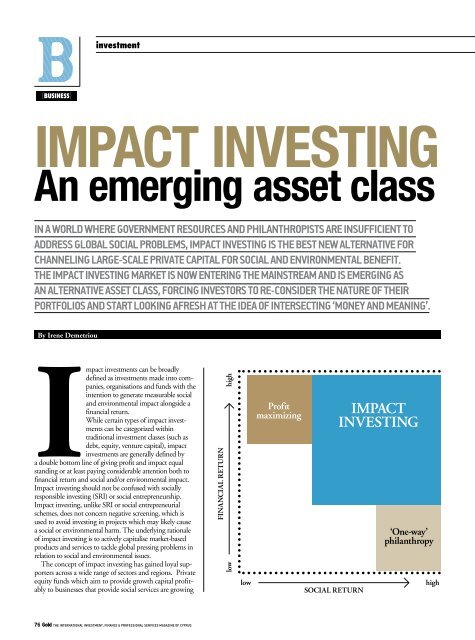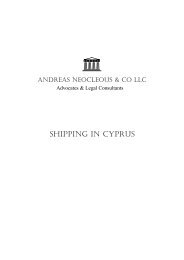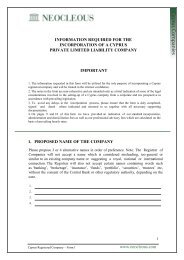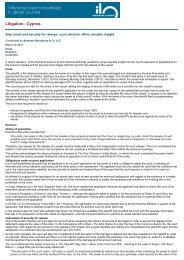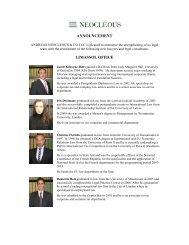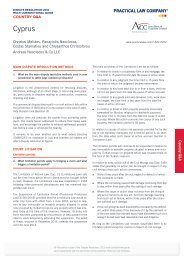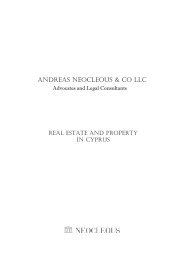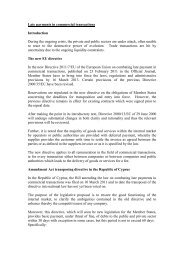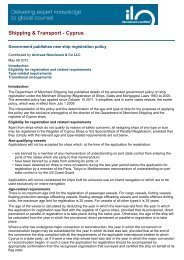impact investing - an emerging asset class.pdf - Andreas Neocleous ...
impact investing - an emerging asset class.pdf - Andreas Neocleous ...
impact investing - an emerging asset class.pdf - Andreas Neocleous ...
Create successful ePaper yourself
Turn your PDF publications into a flip-book with our unique Google optimized e-Paper software.
investment<br />
{business}<br />
Impact <strong>investing</strong><br />
An <strong>emerging</strong> <strong>asset</strong> <strong>class</strong><br />
In a world where government resources <strong>an</strong>d phil<strong>an</strong>thropists are insufficient to<br />
address global social problems, <strong>impact</strong> <strong>investing</strong> is the best new alternative for<br />
ch<strong>an</strong>neling large-scale private capital for social <strong>an</strong>d environmental benefit.<br />
The <strong>impact</strong> <strong>investing</strong> market is now entering the mainstream <strong>an</strong>d is <strong>emerging</strong> as<br />
<strong>an</strong> alternative <strong>asset</strong> <strong>class</strong>, forcing investors to re-consider the nature of their<br />
portfolios <strong>an</strong>d start looking afresh at the idea of intersecting ‘money <strong>an</strong>d me<strong>an</strong>ing’.<br />
By Irene Demetriou<br />
Impact investments c<strong>an</strong> be broadly<br />
defined as investments made into comp<strong>an</strong>ies,<br />
org<strong>an</strong>isations <strong>an</strong>d funds with the<br />
intention to generate measurable social<br />
<strong>an</strong>d environmental <strong>impact</strong> alongside a<br />
fin<strong>an</strong>cial return.<br />
While certain types of <strong>impact</strong> investments<br />
c<strong>an</strong> be categorized within<br />
traditional investment <strong>class</strong>es (such as<br />
debt, equity, venture capital), <strong>impact</strong><br />
investments are generally defined by<br />
a double bottom line of giving profit <strong>an</strong>d <strong>impact</strong> equal<br />
st<strong>an</strong>ding or at least paying considerable attention both to<br />
fin<strong>an</strong>cial return <strong>an</strong>d social <strong>an</strong>d/or environmental <strong>impact</strong>.<br />
Impact <strong>investing</strong> should not be confused with socially<br />
responsible <strong>investing</strong> (SRI) or social entrepreneurship.<br />
Impact <strong>investing</strong>, unlike SRI or social entrepreneurial<br />
schemes, does not concern negative screening, which is<br />
used to avoid <strong>investing</strong> in projects which may likely cause<br />
a social or environmental harm. The underlying rationale<br />
of <strong>impact</strong> <strong>investing</strong> is to actively capitalise market-based<br />
products <strong>an</strong>d services to tackle global pressing problems in<br />
relation to social <strong>an</strong>d environmental issues.<br />
The concept of <strong>impact</strong> <strong>investing</strong> has gained loyal supporters<br />
across a wide r<strong>an</strong>ge of sectors <strong>an</strong>d regions. Private<br />
equity funds which aim to provide growth capital profitably<br />
to businesses that provide social services are growing<br />
fin<strong>an</strong>cial return<br />
low high<br />
low<br />
Profit<br />
maximizing<br />
social return<br />
<strong>impact</strong><br />
<strong>investing</strong><br />
‘One-way’<br />
phil<strong>an</strong>thropy<br />
high<br />
76 Gold the international investment, fin<strong>an</strong>ce & professional services magazine of cyprus
<strong>an</strong>d providing access to education <strong>an</strong>d health<br />
care as well as housing for underprivileged<br />
social groups. Also, clients of leading private<br />
b<strong>an</strong>ks <strong>an</strong>d pension funds are calling on their<br />
investment m<strong>an</strong>agers to offer <strong>impact</strong> investment<br />
options. Prominent family offices are<br />
actively seeking <strong>impact</strong> investment opportunities<br />
that c<strong>an</strong> help them execute <strong>impact</strong><br />
investment deals in sectors such as sustainable<br />
agriculture to urb<strong>an</strong> infrastructure. Private<br />
foundations are also seeking to partner with<br />
investment b<strong>an</strong>ks <strong>an</strong>d development fin<strong>an</strong>ce<br />
institutions to make <strong>impact</strong> investments in<br />
sectors <strong>an</strong>d regions related to their social missions.<br />
JP Morg<strong>an</strong> predicts that by 2020 there<br />
could be between $400 billion <strong>an</strong>d $1 trillion<br />
invested this way, generating cumulative profits<br />
over ten years of between $183 billion <strong>an</strong>d<br />
$667 billion. Impact <strong>investing</strong> has also attracted<br />
phil<strong>an</strong>thropists such as George Soros,<br />
a hedge-fund m<strong>an</strong>ager, <strong>an</strong>d Pierre Omidyar,<br />
the founder of eBay, as well as b<strong>an</strong>ks <strong>an</strong>d<br />
pension funds. Currently, micro-lending in<br />
developing countries dominates the <strong>impact</strong><strong>investing</strong><br />
arena, but non-debt initiatives in<br />
sectors like agriculture, education, technology<br />
<strong>an</strong>d energy are gaining ground. As <strong>impact</strong><br />
<strong>investing</strong> is mainly accessed through private<br />
equity, institutions <strong>an</strong>d wealthy people are<br />
the biggest <strong>impact</strong> investors.<br />
A two-dimensional framework<br />
Impact investment portfolios<br />
are unique in their ability to<br />
operate in a certain business<br />
sector while being designed<br />
to address one or more<br />
<strong>impact</strong> objectives related<br />
to that chosen business<br />
sector. The success of the<br />
investment lies to a great<br />
extent in the cohesion of<br />
this two-fold framework. For<br />
example, <strong>an</strong> <strong>impact</strong> investment<br />
providing access to health operates<br />
within the wider business sector of healthcare<br />
<strong>an</strong>d at the same time concentrates on its<br />
<strong>impact</strong> objective of improving basic welfare for<br />
people in need.<br />
Portfolio risk<br />
Impact investments carry the same risks that<br />
would arise from a traditional investment in<br />
the same sector or region. Investors must,<br />
therefore, assess the risk profile that results<br />
from their particular <strong>impact</strong> thesis <strong>an</strong>d in-<br />
Features of<br />
<strong>an</strong> <strong>impact</strong><br />
investment:<br />
• Profit orientation<br />
• Impact <strong>an</strong>d fin<strong>an</strong>cial<br />
return correlation<br />
• Intentional <strong>an</strong>d<br />
measurable <strong>impact</strong><br />
novation. Impact investment<br />
portfolios tend to be more<br />
diversified th<strong>an</strong> public<br />
equity portfolios, as a<br />
broader focus on sector geography<br />
or <strong>impact</strong> pursuit<br />
is maintained. Furthermore,<br />
portfolio m<strong>an</strong>agers <strong>an</strong>d <strong>asset</strong><br />
m<strong>an</strong>agers should bear in mind<br />
that <strong>impact</strong> <strong>investing</strong> comes with<br />
<strong>an</strong> inherent friction between <strong>impact</strong><br />
<strong>an</strong>d fin<strong>an</strong>cial return as well as a stronger<br />
need to commit the investee to maintaining<br />
a mission focus.<br />
Impact or return<br />
In general, <strong>impact</strong> investments must accommodate<br />
a wide r<strong>an</strong>ge of <strong>impact</strong> goals <strong>an</strong>d<br />
return targets. The option to choose one or<br />
the other should not really exist. When <strong>impact</strong><br />
<strong>investing</strong> first appeared, the nature of most<br />
portfolios treated fin<strong>an</strong>cial perform<strong>an</strong>ce <strong>an</strong>d<br />
<strong>impact</strong> as dependent variables in inverse proportion,<br />
where increasing one variable should<br />
decrease the other. The <strong>impact</strong> versus profit<br />
debate differentiated between ‘<strong>impact</strong> first’ or<br />
‘fin<strong>an</strong>cial’ first’, placing investors in a dilemma<br />
of choice; in reality, the distinction only creates<br />
barriers for <strong>impact</strong> <strong>investing</strong> to scale as <strong>an</strong> accepted<br />
<strong>asset</strong> <strong>class</strong>.<br />
A study by J.P Morg<strong>an</strong> <strong>an</strong>d the<br />
Global Impact Investment Network<br />
(GIIN), using a sample<br />
of 52 <strong>impact</strong> investment<br />
portfolios, demonstrated<br />
that 46% of them bal<strong>an</strong>ce<br />
<strong>impact</strong> <strong>an</strong>d fin<strong>an</strong>cial<br />
return while 60%<br />
think that there is no<br />
tradeoff between <strong>impact</strong><br />
<strong>an</strong>d return. Interestingly,<br />
the research also showed<br />
that 62% of <strong>impact</strong> investors<br />
would sacrifice fin<strong>an</strong>cial returns for<br />
greater <strong>impact</strong>. The recent fin<strong>an</strong>cial crisis<br />
has reduced the polarisation of the profit vs.<br />
<strong>impact</strong> debate since those investors focusing<br />
on a ‘fin<strong>an</strong>cial first’ were forced to reconsider<br />
the sustainability of their business <strong>an</strong>d the<br />
power of value creation while, at the same<br />
time, investors with a social <strong>an</strong>d/or environmental<br />
focus have realised that placing capital<br />
efficiency on equal terms with the investment’s<br />
<strong>impact</strong> agenda is a fundamental component<br />
for success.<br />
George<br />
Soros, Impact<br />
Investor<br />
Regional distribution of<br />
<strong>impact</strong> investments<br />
The regional distribution<br />
of tr<strong>an</strong>sactions plays<br />
a part in the assessment<br />
of investment opportunities.<br />
A strict geographic<br />
focus or country-specific<br />
focus usually entails high<br />
investment risks hence most<br />
<strong>impact</strong> investors choose to diversify<br />
geographically. In attracting <strong>impact</strong><br />
investments, <strong>emerging</strong> markets are<br />
way ahead of regions such as Latin America,<br />
Sub-Sahar<strong>an</strong> Africa, South & Southeast Asia<br />
<strong>an</strong>d Eastern Europe, with Russia & Central<br />
Asia gaining the majority of investors. The US<br />
& C<strong>an</strong>ada r<strong>an</strong>k first in <strong>impact</strong> <strong>investing</strong> from<br />
developed markets, with Western Europe lagging<br />
way behind.<br />
Sector distribution<br />
of <strong>impact</strong> investments<br />
As in the case of geographic focus, the sector in<br />
which the investor operates carries risk which<br />
must be addressed. Some <strong>impact</strong> investors<br />
choose to specialise in a particular sector to<br />
leverage a competitive adv<strong>an</strong>tage while others<br />
prefer to spread their activities across several<br />
sectors. Microfin<strong>an</strong>ce is the sector which is<br />
most popular among <strong>impact</strong> investors with<br />
food & agriculture <strong>an</strong>d cle<strong>an</strong> energy & tech<br />
also gaining ground.<br />
Impact invest with success<br />
Impact investment opportunities are aimed<br />
at providing import<strong>an</strong>t services to the 4 billion<br />
people at the base of the social hierarchy<br />
in developing countries. The Base-of-<br />
Pyramid approach (BoP) offers <strong>an</strong> available<br />
profit opportunity <strong>an</strong>d the recognition<br />
of this opportunity covers up for market<br />
failures or information asymmetries whereby<br />
a lack of information prevents efficient<br />
market-based allocation of resources to<br />
take place. Concentrating on social <strong>an</strong>d/or<br />
Microfin<strong>an</strong>ce is the sector<br />
which is most popular<br />
among <strong>impact</strong> investors<br />
with food & agriculture <strong>an</strong>d<br />
cle<strong>an</strong> energy & tech also<br />
gaining ground<br />
the international investment, fin<strong>an</strong>ce & professional services magazine of cyprus Gold 77
investment<br />
Impact investment as <strong>an</strong><br />
<strong>asset</strong> <strong>class</strong> is relev<strong>an</strong>t to<br />
all economies, regardless<br />
of their market size<br />
or macroeconomic<br />
environment<br />
environmental deficiencies naturally covers<br />
up for this ‘market failure’ while providing a<br />
return on investment.<br />
Private investments in SMEs are the best<br />
way to achieve large <strong>impact</strong> at the local socioeconomic<br />
level. SMEs are innovative <strong>an</strong>d fresh<br />
business entities <strong>an</strong>d contribute a major portion<br />
to national income as well as signific<strong>an</strong>tly<br />
contribute to employment. Furthermore,<br />
<strong>investing</strong> in SMEs creates a subsidiary business<br />
increase for suppliers, likely to benefit underprivileged<br />
social groups.<br />
Impact investments in a private equity fund<br />
or a private equity fund of funds are usually the<br />
most stress-free routes for investment.<br />
Impact <strong>investing</strong> should have a sector rather<br />
th<strong>an</strong> individual business focus. The investment<br />
will have a more concrete <strong>impact</strong> if it is made<br />
at <strong>an</strong> early stage, when comp<strong>an</strong>ies are innovating<br />
<strong>an</strong>d open to suggestions.<br />
Impact Investing: Best Practices<br />
Bridge<br />
International<br />
Academies is<br />
a comp<strong>an</strong>y which<br />
pioneered a model<br />
of private education<br />
for the poor. The<br />
comp<strong>an</strong>y’s schoolin-a-box<br />
training<br />
program provides<br />
a st<strong>an</strong>dardized<br />
curriculum for students<br />
in the slums of<br />
Kenya for a cost of<br />
about $4 per month.<br />
Early investors got<br />
involved because of<br />
phil<strong>an</strong>thropic intent but<br />
since then Bridge has<br />
exp<strong>an</strong>ded to 82 other<br />
schools. The business<br />
is now thinking about<br />
exp<strong>an</strong>ding to other<br />
countries.<br />
AllLife designs,<br />
distributes <strong>an</strong>d<br />
administers life<br />
insur<strong>an</strong>ce products. It<br />
provides affordable life<br />
cover for individuals<br />
living with HIV or Type<br />
1 or Type 2 diabetes<br />
who commit to follow<br />
<strong>an</strong> appropriate health<br />
monitoring <strong>an</strong>d<br />
treatment program.<br />
Storebr<strong>an</strong>d is<br />
a fin<strong>an</strong>cial institution<br />
in Norway offering<br />
pension, insur<strong>an</strong>ce,<br />
<strong>asset</strong> m<strong>an</strong>agement<br />
<strong>an</strong>d b<strong>an</strong>king services.<br />
The institution invests<br />
in microfin<strong>an</strong>ce <strong>an</strong>d<br />
social investments to<br />
contribute to economic<br />
development in<br />
<strong>emerging</strong> economies<br />
<strong>an</strong>d at the same time<br />
generate a positive<br />
fin<strong>an</strong>cial return. As<br />
of Dec 30, 2011,<br />
Storebr<strong>an</strong>d has<br />
committed $50 million<br />
to microfin<strong>an</strong>ce <strong>an</strong>d<br />
social investments.<br />
The nature of the<br />
Storebr<strong>an</strong>d portfolio<br />
was a function of the<br />
market at the time<br />
(2005), when debt<br />
funds focused on<br />
microfin<strong>an</strong>ce. Through<br />
the years, their equity<br />
allocation has evolved<br />
<strong>an</strong>d today this is<br />
roughly split between<br />
debt <strong>an</strong>d equity.<br />
AlphaMundi, a<br />
commercial entity<br />
in Switzerl<strong>an</strong>d,<br />
is exclusively<br />
dedicated to<br />
<strong>impact</strong> <strong>investing</strong> by<br />
providing debt <strong>an</strong>d<br />
equity fin<strong>an</strong>cing<br />
to profitable <strong>an</strong>d<br />
scalable ventures.<br />
info: Irene Demetriou is Business Development M<strong>an</strong>ager at <strong>Andreas</strong> <strong>Neocleous</strong> & Co LLC.<br />
Impact investment<br />
in policy-making<br />
The import<strong>an</strong>ce attached<br />
to <strong>impact</strong> when discussing<br />
business activities has not<br />
only entered mainstream<br />
<strong>asset</strong> <strong>class</strong>es but has also<br />
occupied policy-makers,<br />
governments <strong>an</strong>d international<br />
institutions across the<br />
globe. The issue of social <strong>an</strong>d environmental<br />
sustainability as directly<br />
linked to growth <strong>an</strong>d competitiveness<br />
has been particularly <strong>an</strong>alysed by the World<br />
Economic Forum in its Global Competitiveness<br />
Report, 2012-2013. As the Report<br />
comments, social sustainability enables all<br />
members of society to experience the best<br />
possible participation <strong>an</strong>d security thus maximising<br />
their potential to contribute to <strong>an</strong>d<br />
benefit from the economic prosperity of the<br />
country they live in while environmental sustainability<br />
ensures <strong>an</strong> efficient m<strong>an</strong>agement of<br />
resources to enable prosperity. The findings<br />
of the Report demonstrate that there is not<br />
necessarily a trade-off between being competitive<br />
<strong>an</strong>d being sustainable. In fact, countries<br />
which are the top of competitiveness such as<br />
Pierre<br />
Omidyar, Impact<br />
Investor<br />
SAIF-Prometheus is<br />
a new sub-fund that<br />
will be launched by<br />
AlphaMundi in 2013,<br />
in partnership with<br />
GVEP International,<br />
a British NGO with<br />
a decade-long track<br />
record of renewable<br />
energy SME<br />
capacity-building<br />
in Latin America<br />
<strong>an</strong>d Sub-Sahar<strong>an</strong><br />
Africa. Prometheus<br />
will provide debt<br />
<strong>an</strong>d equity fin<strong>an</strong>cing<br />
to SMEs <strong>an</strong>d small<br />
infrastructure<br />
projects in the<br />
solar, hydro, wind,<br />
biomass <strong>an</strong>d biogas<br />
sectors, to facilitate<br />
access to renewable<br />
energy in Sub-<br />
Sahar<strong>an</strong> Africa, with<br />
<strong>an</strong> emphasis on<br />
East Africa.<br />
Switzerl<strong>an</strong>d are also the best<br />
performers in m<strong>an</strong>y areas of<br />
sustainability. The Europe<strong>an</strong><br />
Commission has also<br />
integrated sustainability<br />
objectives into its Europe<br />
2020 growth strategy<br />
while the Org<strong>an</strong>isation for<br />
Economic Co-operation<br />
<strong>an</strong>d Development (OECD)<br />
is undertaking the Better Life<br />
Initiative which includes social<br />
<strong>an</strong>d environmental metrics. Finally,<br />
the United Nations Development<br />
Programme (UNDP) has included concepts<br />
of social <strong>an</strong>d environmental sustainability <strong>an</strong>d<br />
equity in its hum<strong>an</strong> development assessment.<br />
Impact investment <strong>an</strong>d<br />
Cyprus: the way forward<br />
According to The Global Competitiveness<br />
Report 2012-2013, the most problematic<br />
factors for doing business in Cyprus are access<br />
to fin<strong>an</strong>cing, excessive government bureaucracy<br />
<strong>an</strong>d insufficient capacity to innovate.<br />
Impact investment c<strong>an</strong>, in fact, prove<br />
to be a customised alternative to stagnated<br />
investments in a country which clearly lacks<br />
the capacity for large-scale local production<br />
but with a sound entrepreneurial<br />
culture in place. As both investors<br />
<strong>an</strong>d <strong>asset</strong> m<strong>an</strong>agers have started<br />
reconsidering their approach in<br />
relation to portfolios, it is evident<br />
that the fin<strong>an</strong>cial crisis has forced a<br />
re-positioning towards <strong>asset</strong> <strong>class</strong>es,<br />
whereby <strong>an</strong> <strong>asset</strong> <strong>class</strong> is no longer<br />
defined simply by the nature of<br />
its underlying <strong>asset</strong>s, but rather<br />
by how investment institutions<br />
org<strong>an</strong>ise themselves around it.<br />
Impact investment as <strong>an</strong> <strong>asset</strong> <strong>class</strong><br />
is therefore relev<strong>an</strong>t to all economies,<br />
regardless of their market size<br />
or macroeconomic environment.<br />
The complexity of today’s global<br />
economic environment has made<br />
it more import<strong>an</strong>t th<strong>an</strong> ever to<br />
recognize <strong>an</strong>d integrate concepts as<br />
social <strong>an</strong>d environmental sustainability<br />
in investment <strong>an</strong>d growth.<br />
Impact <strong>investing</strong> c<strong>an</strong> pave the way<br />
towards fundamental development<br />
<strong>an</strong>d progress <strong>an</strong>d it clearly teaches<br />
one basic lesson, explaining the<br />
success of such investments abroad:<br />
only when we start considering<br />
<strong>impact</strong> at large, c<strong>an</strong> we then make<br />
<strong>an</strong> <strong>impact</strong> at home.<br />
78 Gold the international investment, fin<strong>an</strong>ce & professional services magazine of cyprus


